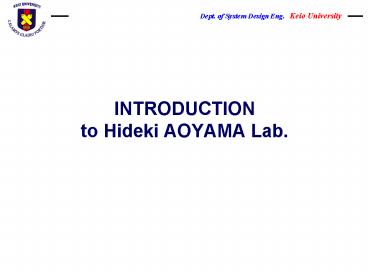INTRODUCTION to Hideki AOYAMA Lab' - PowerPoint PPT Presentation
1 / 37
Title:
INTRODUCTION to Hideki AOYAMA Lab'
Description:
for Digital Design & Digital Manufacturing, Dept. of System Design Eng. ... Front window line. Roof line. Rear window line. Base line. Face line. Tail line. Lab. ... – PowerPoint PPT presentation
Number of Views:45
Avg rating:3.0/5.0
Title: INTRODUCTION to Hideki AOYAMA Lab'
1
INTRODUCTIONto Hideki AOYAMA Lab.
2
Research Fields
- Digital Design Systems
- Digital Style (Aesthetic) Design
- CAD (Computer Aided Design)
- Digital Manufacturing Systems
- CAM (Computer Aided Manufacturing)
- Product Process Analysis
- Others
3
(No Transcript)
4
(No Transcript)
5
Digital Style (Aesthetic) Design
6
Current Aesthetic Design Processes
Measurement process (Reverse Eng.)
7
Sketch Clay Model
8
Sketch, Clay Model, Product
9
ProposedAesthetic Design Processes
Re-Modeling by Highlight Lines and
Characteristic Lines
Engineer
Evaluation
Proposition
Data-Base
Modeling from Sketch
Modeling by Virtual Clay Model system
Modeling from Rough Physical Model
Modeling from Kansei Language
Modeling from silhouette Lines
10
Chair Design System from Sketch
Evaluation of Structural Stability
Digital human model
Evaluation of Comfortable sitting
Sketch
3D Model
11
Virtual Clay Modeling System
User Interfaces
System
3D Glasses
Output
Computer for execute the application
Virtual Tool
Position Orientation
Force feedback device
Position Orientation
Force
Force
Computer for control the hardware
Input
Virtual Hand
Finger Joints Angles
Data Glove
Position Orientation
Position tracker
12
Devices forVirtual Clay Modeling System
Head Mounted Display
Data groves
Force Feed Back Device
13
Virtual Tool
14
Result Constructed byVirtual Clay Modeling System
15
Style (Aesthetic) Design Based on KANSEI Language
This system constructs a form of a designed
product by using the Kansei language.
What is the Kansei language?
- Kansei language expresses humans feeling or
sense.
Procedure to construct form from Kansei Language
- Lamsei Languages are transformed into the factor
coefficients by the factor analysis. - Form parameters are derived from the factor
coefficients by a neural network
16
A Result of Modeling by KANSEI Language
Kansei Languages Cute Sporty Sort Formal Casual Sp
acious Powerful Stable Luxurious Un-tired
3 points5 points3 points3 points3 points3 points3
points3 points3 points3 points
Result
17
Modeling System Based on Characteristic Lines
What are Characteristic Lines? Characteristic
lines are the base lines of the form to directly
characterize the product image.
18
Modeling System Based on Characteristic Lines
Objective of This Study To develop a system to
construct more desired 3D car models from a basic
model by characteristic lines.
characteristic line
Type B
19
Modeling SystemBased on High-Light Lines
- What is the high-light lines?
- Reflecting lines of fluorescent lights
- Most important parameter expressing form
impression
High-light lines on a CAD model
High-light lines on a physical model
Objective Development of a system to construct a
computer model from highlight lines.
20
Results of ModelingBased on High Light Lines
Before Processing
After Processing
Curvature
21
Modeling System Based on Silhouette lines
objective
To develop a system to construct the 3-D model of
an automobile from the silhouette lines and
boundary lines.
External form design is creative activity
depending on designers sensibility.
Designers often get the idea of a designing
product form as silhouette lines and boundary
lines .
22
Whats Silhouette Line?
Silhouette Lines
MAZDA RX-8
23
Whats Boundary Line?
Boundary Lines
MAZDA RX-8
24
Flow of developed system
Input silhouette and boundary lines
Construction of basic surfaces
Construction of connecting surfaces
25
Input Silhouette Lines
26
Constructed Model
27
CAM Systems
28
Off-line Robot Teaching System Using VR Devices
Determination of Optimum Welding Path by Genetic
Algorithm
29
Advanced CAM System
Estimation of Cutting Force
Cutting Tool Diameter 15(mm)
Workpiece Carbon steel
Rotating speed 1,000(rpm)
Feed rate 0.1(mm/tooth)
Depth of cut in axial direction 10(mm)
Depth of cut in radial direction 2(mm)
30
Method to determine the optimum feed rate
Advanced CAM System
maximum feed rate under permissible cutting force
optimum feed rate
31
Advanced CAM System
Result of calculating the optimun feed rate
before modification after modification
Calculated cutting force
Radial depth of cut 2.0 mm
Axial depth of cut 4.0 mm
Spindle speed 2300 rpm
Workpiece S55C
Tool 2 flute ball-endmill (f 10 mm)
Measured cutting force
32
Advanced CAM System
100
mm
Goal point (0,100)
fixturing point A
fixturing point D
Workpiece
C(90,90)
mm
B(30,80)
Tool
100
A(30,20)
fixturing point C
Y
fixturing point B
D(90,10)
Starting point (0,0)
X
Z
Optimum fixturing force
Radial depth of cut 2.0 mm
Fa 2105 N
Axial depth of cut 3.0 mm
Fb 1971 N
Spindle speed 1500 rpm
Fc 1399 N
Workpiece S55C, feed rate 0.06 mm/rev
Fd 1803 N
Tool 2 flute square-endmill (f 10 mm)
33
Management of Machine Tools with Internet
and Construction Know-how Data-Base of Skilled
Workers
Management Commands
Network
Parameters from NC Controler
The objective is to develop a system to manage
the machine tools with the internet and the open
technology of the NC control device, and to
construct know-how data base of skilled workers
by analysis their operations.
34
Manufacturing Processes
35
Development of Sensor to detect Cutting Force
Components, Cutting Torque, and Tool Deformation
Developed Sensor
36
Flow Analysis for Injection Molding
(Thixomolding) of Magnesium Alloy Based on FEM
Recently, Mg alloy products are widely used for
notebook-type personal computers, portable MDs,
etc. because of easy recycling and rich resource.
But the injection molding technology for Mg
alloy has not been established yet. Die design
and injecting conditions are determined by
try-and-errors. The objective of this research is
to obtain optimum die design and injecting
conditions by computer simulation.
model
result
37
Thank you for your attention.































